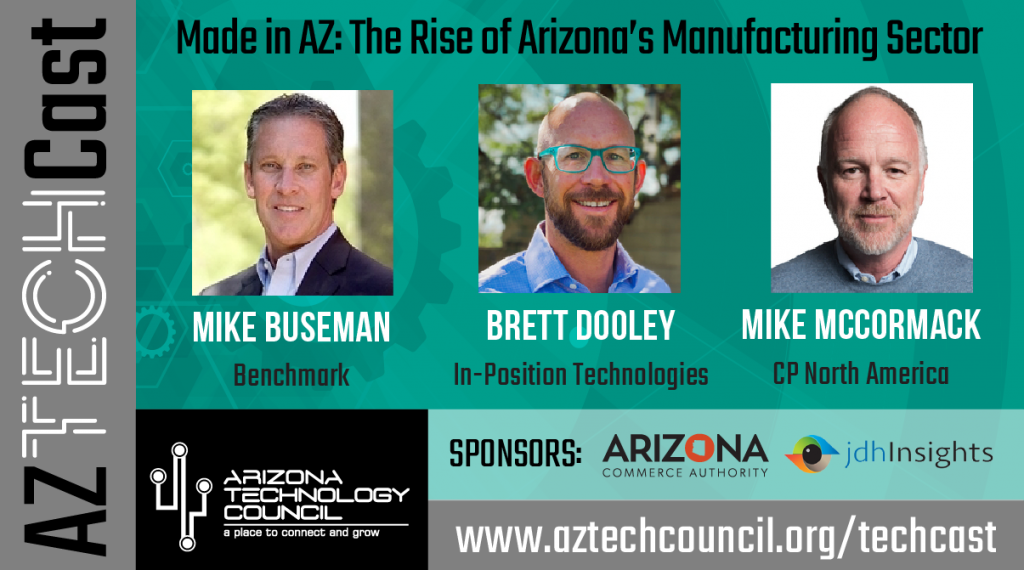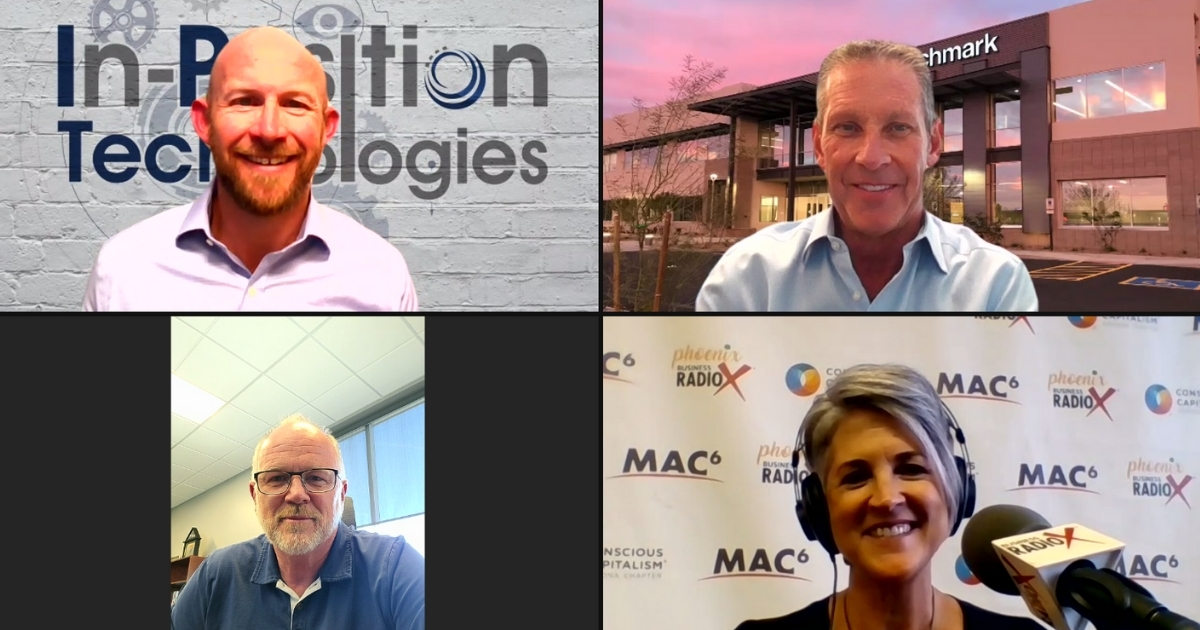October 2021 episode | Made in AZ: The Rise of Arizona’s Manufacturing Sector
Made in Arizona. It’s a phrase that is becoming more familiar as the state’s manufacturing sector continues to grow and add a rapidly increasing number of manufacturing jobs. Between the development of technologies improving efficiency and reducing costs, automation of manufacturing processes...

Episode Overview
Made in Arizona. It’s a phrase that is becoming more familiar as the state’s manufacturing sector continues to grow and add a rapidly increasing number of manufacturing jobs. Between the development of technologies improving efficiency and reducing costs, automation of manufacturing processes and a business-friendly climate, Arizona’s manufacturing landscape is being recognized on a national stage.
In the Arizona Technology Council’s October 2021 episode of AZTechCast, accomplished manufacturing leaders from Benchmark, In-Position Technologies and CP North America joined Phoenix Business RadioX owner and president, Karen Nowicki, to discuss the rapid evolution and development of Arizona’s manufacturing sector.

These leaders included Mike Buseman, EVP and chief operating officer at Benchmark; Brett Dooley, technical sales engineer at In-Position Technologies; and Mike McCormack, president and CEO at CP North America.
Throughout this hour-long episode, this panel of experts explored the various factors that have contributed to Arizona’s rise in manufacturing over the past decade, the newest technologies manufacturers are utilizing to improve efficiency and reduce costs, the automation being implemented to compete with foreign sources and the largest manufacturing challenges they are facing in a post-COVID world, particularly around supply chain and talent acquisition and retention.
“CP North America was originally based in San Diego, but we needed more space to build aircraft and larger systems. From a political and economic perspective, it was advantageous for us to leave California and choose Arizona,” said McCormack. “We chose Arizona because of the established supply chain and thriving local semiconductor and defense industries. There are also plenty of great universities to recruit from. From the Governor’s Office to the Arizona Commerce Authority, local entities made choosing Arizona a simple decision.”
“The manufacturing industry is seeing a growth in jobs where we still need humans, even if the processes are automated,” said Dooley. “A lot of the tasks can be mundane and repetitive, so people can be more productive if robots are handling the mundane items and the human workers are focusing on things like quality assurance and complex assembly tasks. The key to success is hand-in-hand automation with human management. ‘Co-bots’ can be up and running within a day and improve general safety by eliminating the use of forklifts.”
“Workers don’t need four-year degrees or the debt associated with those degrees to work in manufacturing and automation,” said Buseman. “Those who have completed one to two-year vocational programs or apprenticeships have the opportunity to earn better income and provide companies with the talent pool needed to grow and generate needed tax revenue. Automation pays benefits by freeing up organizations to achieve new next-level work objectives.”
The group also discussed how COVID-19 has made manufacturing a geopolitical issue. “In the defense industry, we need to be able to import quickly and COVID-19 has bogged down the supply chain in a way that is shifting our processes from offshoring to onshoring,” said McCormack. “By building an ecosystem here in Arizona, we can avoid the chaos of shipping containers sitting in the port of L.A. for four to six weeks because they can’t get into port.”
In closing, Dooley mentioned the importance of companies investing in renewables to sustain Arizona’s growing manufacturing sector and supply chain. “That’s how we’ll keep water supply and the electric grid where they need to be. By focusing on that and engaging the large talent pool in the area at young ages, we will continue seeing new companies move here and continue making big breakthroughs.”
|
|
|
|
About AZTechCast
The official podcast of the Arizona Technology Council, AZTechCast is dedicated to covering innovation and technology in Arizona and beyond. Through the art of the connected conversation, AZ TechCast’s hosts and guests share success stories, tech news and analysis about the region’s leading startups, companies and emerging technologies, as well as the latest industry trends and critical issues propelling Arizona’s growing technology ecosystem. Visit www.aztechcouncil.org/techcast to learn more or to listen to recent episodes.
About Phoenix Business RadioX
Karen Nowicki is the owner and president of Phoenix Business RadioX. Amplifying the voice of business, Phoenix Business RadioX helps local businesses and professional associations get the word out about the important work they’re doing to serve their market, profession and community. A successful author, speaker and the creator of Deep Impact Leadership™ and SoulMarks Coaching™, Nowicki is a two-time recipient of the prestigious national Choice Award® for her book and personal development retreat. In addition, Nowicki has been an expert guest on regional TV and radio shows, including Fox Phoenix Morning Show, Sonoran Living, Good Morning Arizona, The Chat Room and Mid-Day Arizona. Recognized for her leadership and business acumen, she has been a regular contributor to many print and online magazines – publishing articles and blogs for business and education.







